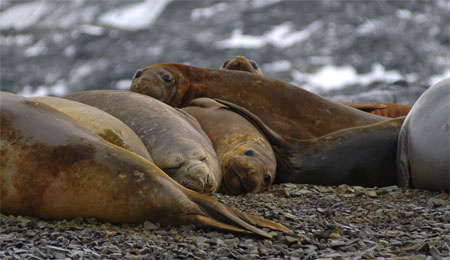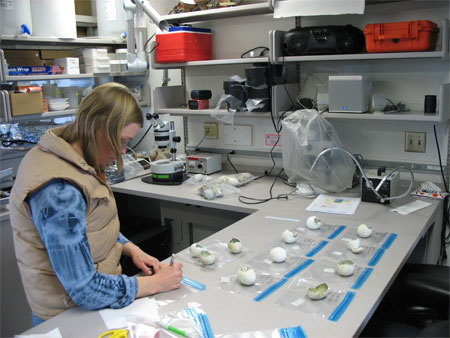|
Local extinctionAdélie penguins disappearing from Palmer LTER study areaPosted March 28, 2008
Seabird ecologist Bill Fraser first visited the Antarctic Peninsula in 1974. Back then, about 15,200 breeding pairs of Adélie penguins nested on islands close to Palmer Station, a U.S. research facility near the northern tip of the peninsula on Anvers Island. Today there are an estimated 3,000 breeding pairs within a 50-square-kilometer area near the station, a drop of about 82 percent over the last three decades. “The trend is straight down,” said Fraser, with the Polar Oceans Research Group, a private nonprofit organization in Sheridan, Mont., and principal investigator (PI) of the seabird component of the Palmer Long Term Ecological Research (PAL LTER) project. U.S. scientists involved in the PAL LTER say their study site is undergoing some of the most significant climate change on the planet. Rising air temperature combined with the flooding of warm ocean water along the continental shelf are creating a subantarctic climate and driving local polar species such as the Adélies to the brink of regional extinction. Adélies are particularly vulnerable because of their symbiotic relationship with sea ice, which serves as an important grazing area for krill, the shrimp-like meat and potatoes of any Adélie diet. Winter sea ice, which is forming later and melting earlier, is also an important winter habitat for the penguins. “There is no more perennial sea ice on the western Antarctic Peninsula except for this one tiny residual component down to the south,” Fraser said. A colleague from Lamont-Doherty Earth Observatory of Columbia University, Sharon Stammerjohn, has shown winter sea ice duration has decreased significantly since the 1950s, according to Fraser. “We now have winters that for three months don’t have sea ice associated with them,” he said. Doug Martinson, a co-PI on the PAL LTER and a senior research scientist at Lamont-Doherty Earth Observatory of Columbia University, remarked, “That is just a staggering change in the sea ice distribution.” Fraser said he and his team recently confirmed the first extinction of an entire Adélie rookery at Litchfield Island. “By extinction, I mean that there are no more birds breeding on that island,” he said. That’s the first time in 600 years that Litchfield Island has been free of Adélies, Fraser said, based on the paleoecological record. Glacier scour erased evidence of any earlier habitation, he added, but estimated Litchfield once supported up to 15,000 breeding pairs in the last six centuries. 
Photo Credit: Glenn E. Grant
Elephant seals are another subantarctic species thriving in the changing climate around the Antarctic Peninsula.
“We see the same thing on similar vulnerable islands,” Fraser said, predicting the next extinctions will occur on Cormorant and Christine islands. “This is probably going to happen in quick succession,” he said. “I’m guessing within three years these two islands will be devoid of Adélies.” A small residual population on Humble Island may survive the climatic shift down the peninsula, Fraser guessed, but the overall prognosis is that in the next decade the Adélies around Palmer will be gone. “Their numbers are in catastrophic decline,” Fraser said. Gentoos and chinstraps, two subantarctic penguin species, appear to be riding the wave of climate change south, quickly moving in to areas abandoned by the Adélies. The gentoos, larger than Adélies, are particularly doing well in the warmer, moister climate, as their population has increased about 8,000 percent since 1994, adding as many 10 new small colonies each year. The two subantarctic penguin species, which have evolved to survive in the new climate, are outperforming their polar-desert loving cousin for a number of reasons, Fraser explained. For example, the gentoos breed later in the austral summer than the Adélies. That’s important because heavier snow precipitation is literally burying the Adélies’ nesting areas. The eggs and chicks then drown in the ensuing flood when all that snow melts. “Some of the heavy snow years absolutely devastated reproductive successes,” Fraser said, estimating that at least 50 percent of the breeding pairs lose their eggs or chicks to flooding and drowning. The scientists have witnessed entire colonies blanketed by snow, the only evidence of their existence a sea of short beaks peaking through the white layer. “We can see the birds in these tiny snow caves breathing through these air holes,” Fraser said. “The birds will not abandon the eggs.” Will gentoos and chinstraps successfully replace the Adélies in the emerging ecosystem? “That’s the $64,000 question,” Fraser said. All three rely on krill for calories during the summer breeding season, and the small invertebrates are under their own set of environmental pressures. Commercial fishing may add to the potential for scarcity, as demand for krill in the aquaculture and pharmaceutical industries grows, according to recent media reports. However, in the absence of krill, the gentoos and chinstraps appear more capable of shifting their diet to fish compared to Adélies, Fraser said. For instance, gentoos can diver deeper than Adélies can, perhaps finding more food at depth, while chinstraps can feed at night, when some fish come closer to the surface. Birds of many feathersFraser’s work includes surveys of all the seabirds around Palmer Station, not just penguins. The news is pretty good for most of the species whose life histories don’t depend on sea ice, such as the southern giant petrel and the south polar skua, both large and aggressive predators. But the brown skua, which typically dines on Adélie penguin eggs and chicks, is also in steep decline, as its food source disappears. Another species in regional collapse is the blue-eyed shag, according to Fraser. There are only 30 breeding pairs left on Cormorant Island, out of an original study population of 1,000. A likely contributor to the freefall, Fraser said, was a 1989 oil spill caused by the Bahia Paraiso, an Argentine ship that ran aground and capsized near Palmer Station. “The oil spill probably really accelerated the process,” he added. “The remarkable thing is that those 30 breeding pairs are still maintaining at that level.” NSF-funded research in this story: Bill Fraser, Polar Oceans Research Group. Return to main story: Getting warmer |



For USAP Participants |
For The Public |
For Researchers and EducatorsContact UsU.S. National Science FoundationOffice of Polar Programs Geosciences Directorate 2415 Eisenhower Avenue, Suite W7100 Alexandria, VA 22314 Sign up for the NSF Office of Polar Programs newsletter and events. Feedback Form |


